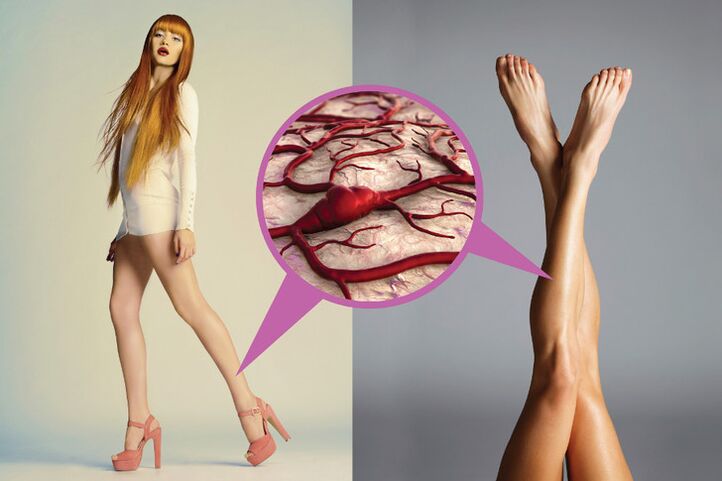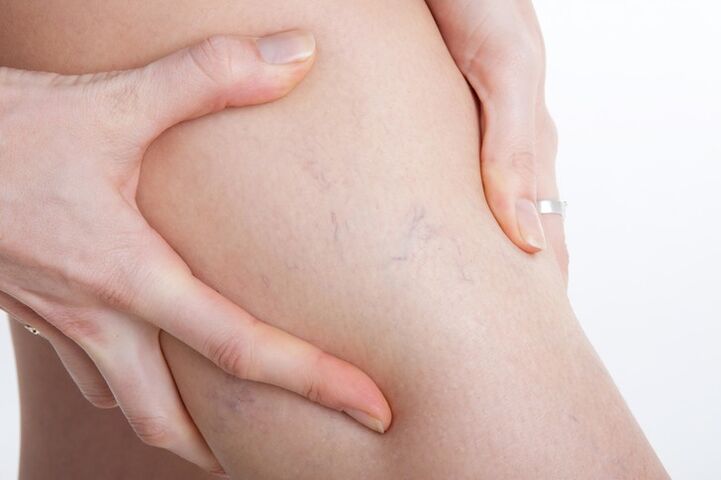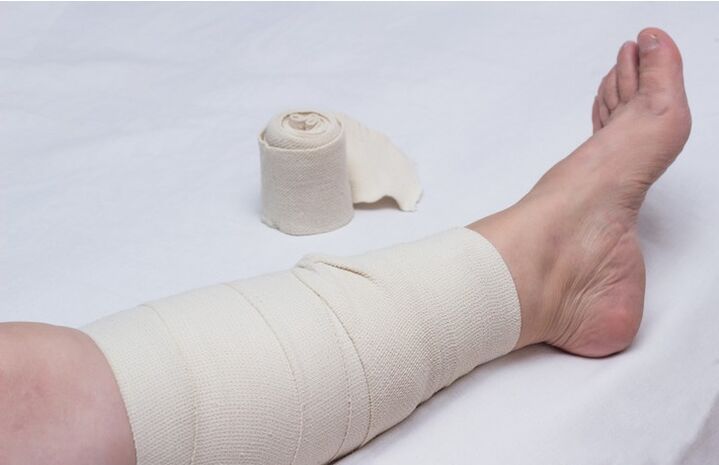Every woman wants her legs to always be in great shape. But what if one day, in front of the mirror, you discover that her legs are covered in obnoxious vascular "stars"? The disguise doesn't work. It's impossible to ignore it, as these "decorations" will only get brighter and bigger. The fight against varicose veins in the lower extremities, although not easy, is necessary. After all, you must agree that wearing pants forever isn't the most tempting prospect.

Varicose veins in the legs are a serious condition in which the veins lose elasticity, stretch, dilate and bend.
Varicose veins in the legs have long been known as a serious disease. Overall, not very pleasantly, we paid for the opportunity to walk on two legs. The impact of several unfavorable factors leads to weakness of the venous walls and blood stagnation in the lower half of the body.
As a result, the vessels are overloaded and the venous valves function worse and worse. Result - the legs are tired, they ache, there is a feeling of heaviness, the feet and ankles swell. A little later, other symptoms are added in the form of cosmetic imperfections. In the future, more serious complications are possible.
Previously, it was believed that varicose veins in the legs - a disease of people "standing" professions, and the first symptoms appear about 35 years. This is partially true. But today varicose veins are getting younger quickly. It can be said that the disease has already become a problem for the "computer generation" from 20 to 30 years old.
Unfortunately, there are no clearly pronounced symptoms of approaching varicose veins in the legs. But if your legs started to ache and get tired, a heaviness appeared in your legs and you had seizures - that's a reason to watch out.
And the appearance of almost imperceptible bluish veins familiar to many—vascular networks, which later, if left untreated, will become more noticeable—is a sign of action. It is worth raising the alarm when whole bunches of saphenous veins have appeared on the surface of the legs, because the outcome of the disease is ugly blood clots and ulcers, which are very difficult to fight. Treatment for varicose veins in the legs can take decades.
The most dangerous consequence of varicose veins is the development of thrombophlebitis - the formation of a blood clot in a vein.
The inflammatory process that accompanies the disease creates the risk that a thrombus ruptures the vessel wall. And this, in turn, can lead to the development of pulmonary embolism, when a thrombus enters the vessels of the lungs, partially or totally interrupting the functioning of the respiratory system. And it can even lead to death.

Varicose Veins in the Legs: And Does It Threaten Me?
Unfortunately, it is difficult to name the exact cause of the appearance of varicose veins in the legs. This disease is a consequence of several factors. And each of us faces some of them every day.
Reason 1. Heredity
Phlebologists say that varicose veins are a "familial" disease. If a mother or grandmother has suffered from this disease, then 90 percent out of 100 could be argued that you are at risk. Through genes, the characteristics of the structure of blood vessels are transmitted to us. And if the walls of the veins are weak, the influence of any of the triggering factors is enough for the disease to make itself felt.
Reason 2. Pregnancy
Carrying a child is one of the most important triggering factors in the development of varicose veins, since the change in hormone levels leads to a decrease in venous tone. Also, during pregnancy, the veins are almost always compressed by the growing uterus. Also, the weight increases. But our veins are under the greatest pressure during childbirth. According to statistics, in 50 percent of women, varicose veins previously dozing off manifest at this specific time.
Reason 3. Uncomfortable clothes and shoes
Tight and uncomfortable clothing, such as skinny jeans, can cause varicose veins. No less harmful are tight shoes and high heels. The wider the soles of the boots, the less stress on the feet. Balancing on thin stilettos, we subject our veins to an enormous load. And if you also carry heavy bags of groceries in your hands, you can say goodbye to beautiful legs forever.
Reason 4. Working conditions and bad habits
Don't forget about the people who occupy the classic "permanence" professions (salesmen, waiters, hairdressers, flight attendants and many others). They have varicose veins - almost an occupational disease. An entire army of office workers is approaching them, as any prolonged stay in one position (even sitting, even standing) makes their action dirty. And if you add to that bad habits like smoking, eating bread rolls and sandwiches, which lead to being overweight, varicose veins won't keep you waiting. Yes, of course, this also includes the love of many to sit cross-legged.
Reason 5. Sports overload
Not all physical conditioning is good. Lovers of sipping a bar at the gym are at serious risk. Lifting weights is one of the causes of varicose veins. If you are predisposed to varicose veins, you should not overload your legs with excessive exercise. Strength training and martial arts classes are not for you.

Diagnosis and treatment of varicose veins
As has already become clear, varicose veins in the legs are not an aesthetic defect, therefore, with the appearance of the first unpleasant sensations in the legs, a phlebologist should be consulted immediately.
If necessary, the doctor can prescribe Doppler ultrasound, which will determine the quality of blood flow in the vessels and show if there are any obstacles to this, and transillumination - transillumination of superficial veins by means of a special light, which allows the specialist to easily distinguish a vein damaged from a normal one. These necessary measures will allow the incipient disease to be identified in time and to take the necessary measures in a timely manner.
If we talk about the treatment of varicose veins, modern medicine knows several ways to deal with varicose veins:
- Local remedies (ointments, gels):relieves tiredness and heaviness in the legs, has a pleasant calming effect. This method of treatment will not bring instant relief as the active substance penetrates through the skin in small doses. The beneficial effect is only on the superficial saphenous veins. However, with regular use, ointments and gels can correct the situation in the early stages of varicose veins in the legs.
- Venotonic:medicines used for venous insufficiency (prescribed by a doctor only). These medications help to reduce swelling, relieve leg pain, and also strengthen blood vessel walls and improve blood flow. Venotonics perfectly complement the action of local remedies to achieve maximum effect in the treatment of deep veins.
- Endovasal laser coagulation (EVLK):a method of treating vascular "stars" and "networks", precursors to varicose veins in the legs. The doctor acts on the diseased vessel with a laser and the "asterisk" disappears. The procedure is performed under local anesthesia. After a few weeks, there are no reminders of the manipulation on the skin.
- Sclerotherapy:a procedure when substances - sclerosants - are injected into a problematic vein with a syringe, and the affected vein seems to stick to the inside and stop working, and blood starts flowing through healthy veins. But this procedure is not suitable for everyone. It is prescribed if the nodes are not too big.
- Ozone Therapy:a new method of treating varicose veins, used to eliminate spider veins. Ozone is injected with a small needle directly into the vessel's lumen and causes it to stick together. To get a visible effect, several procedures are enough.
- Phlebectomy:surgical intervention, when the diseased vein is removed, is one of the most effective treatment methods. The day after the operation you can go home, but for at least another month you need to wear special pantyhose or bandage your leg. During the operation, small holes are made in the leg, which after a while are almost invisible.
It is widely accepted that hirudotherapy or treating varicose veins with leeches helps to eliminate varicose veins in the legs. In fact, the substance that leeches secrete when bitten, hirudin, helps reduce blood clotting. Neither the spider veins nor the veins disappear anywhere. In addition, ulcers can form at the bite site, which are difficult to heal.
Prevention is the Best Treatment for Varicose Veins: 5 Steps to Vein Health
A healthy lifestyle is the best way to say no to varicose veins and many other diseases!
Step 1. Movement is life
Swimming is a universal physical activity modality, practically devoid of contraindications. Water treatments are best suited for the prevention of varicose veins, as they also tone up the blood vessels. Walking is also a good way to fight venous disease. For example, go up an escalator or stairs. No heavy bags, please. It's better to walk two stops to the subway than to take the shuttle. And at home you can do the most elementary exercise "bike" in the supine position.
Step 2. Elegant helpers
Modern compression knits: pantyhose and high upper help fight fatigue and heaviness in the legs. They are sold in pharmacies and are strictly selected individually by the doctor based on leg parameters. In appearance, medical socks are no less beautiful and elegant than ordinary ones. In addition, they help vessels to better handle the increased load.
Step 3. Delicious and healthy
First, being overweight puts a heavy strain on your blood vessels. So if you have a few unnecessary pounds, it's better to get rid of them. Second, nutrition to prevent varicose veins must be aimed at strengthening the walls of blood vessels. This is facilitated by vitamins such as ascorbic acid and rutin contained in sea buckthorn, raspberries, citrus fruits, chokeberry, strawberries, rose hips and mountain ash. And common buckwheat is rich in the natural antioxidant quercetin, which not only strengthens blood vessels but also has anticancer properties.
Step 4. Beauty without sacrifice
Comfortable shoes with a heel of no more than 4cm are the best choice for every day. In high-heeled shoes, the foot is in a state of forced flexion, as a result, the nutrition of the small vessels in the toes is disturbed, venous congestion, swelling in the ankles and calves occurs.
Step 5. Care and maintenance
To prevent varicose veins on your legs, it is helpful to rinse your legs with cold water after bathing. You can do a massage yourself: caressing movements from the bottom up, from the foot to the groin. Overheating is dangerous for your veins, so if you're prone to varicose veins in your legs, it's best to exclude bathing and sauna from your life. And don't abuse the sun either. Ultraviolet light reduces the elasticity of tissues and venous walls and leads to the appearance of varicose veins. You can sunbathe, but not at midday, but until 11am and after 5pm.
Yes, varicose veins in the legs are a chronic condition. However, timely prevention of varicose veins will help prevent the disease from occurring and reduce the risk of developing possible complications.























